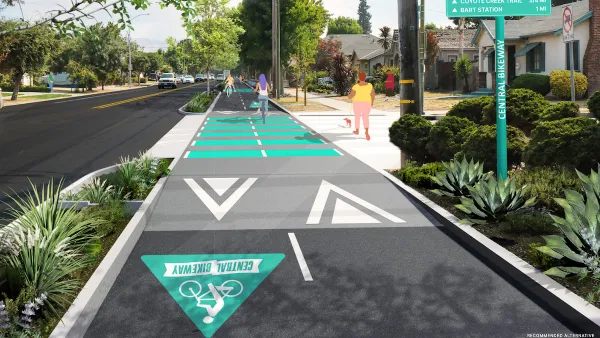A classic example of the notorious ‘stroad,’ aging state roads that aim to serve all users with piecemeal infrastructure solutions fail to facilitate safe, efficient transportation.

In a memorandum released in late July, the U.S. Department of Transportation (USDOT) highlighted the fact that states can take advantage of dozens of federal programs to improve “legacy” or “orphan” highways, reports Jeff Wood in Streetsblog USA.
These roads, built early in a city’s development, have been adjusted and augmented, often haphazardly, to meet the needs of increased traffic and new types of mobility. “That Frankenstein of a human-centered street and a car-centered, highway-style road is often referred to as a ‘stroad’ — and state highway agencies aren't big fans of them either, since all those pesky pedestrians and stoplights make legacy highways highly inefficient at moving cars.” In Washington state, for example, “the crash fatality rate on legacy highways is than three times higher than the rest of the roadway system.”
According to Wood, “states can already leverage 27 different federal programs in the Bipartisan Infrastructure Law to transform these roads with traffic calming measures, wider sidewalks, bike lanes and more. Twelve of those programs are ‘formula’ grants, which means a certain amount of money is guaranteed to each state based on a DOT calculation, and states don't even need to compete for the funds.”
FULL STORY: ‘Legacy Highways’ Are Some of Our Most-Dangerous Stroads — And It’s Time to Fix Them, US DOT Says

Planetizen Federal Action Tracker
A weekly monitor of how Trump’s orders and actions are impacting planners and planning in America.

Silicon Valley ‘Bike Superhighway’ Awarded $14M State Grant
A Caltrans grant brings the 10-mile Central Bikeway project connecting Santa Clara and East San Jose closer to fruition.

Amtrak Cutting Jobs, Funding to High-Speed Rail
The agency plans to cut 10 percent of its workforce and has confirmed it will not fund new high-speed rail projects.

Planting for Change: How Trees Are Powering Climate Action
"Combating Climate Change with Trees" highlights how Southern California communities are strategically planting and nurturing urban forests to cool neighborhoods, improve air quality, and advance environmental justice.

Could Planners Adopt a 'Place Sherpa' Role?
Building upon the framework of a local housing panel, Chuck Wolfe suggests that advocacy and policy discussions would be enhanced by a “sherpa mindset” that focuses on lived experiences, facilitates applied knowledge of urban places, and promotes stakeholder discussion.

California Advances Its 30x30 Conservation Goals
California is making significant progress toward its 30x30 conservation goals, but looming federal rollbacks and gaps in biodiversity protections could threaten the state’s efforts to protect lands and coastal waters by 2030.
Urban Design for Planners 1: Software Tools
This six-course series explores essential urban design concepts using open source software and equips planners with the tools they need to participate fully in the urban design process.
Planning for Universal Design
Learn the tools for implementing Universal Design in planning regulations.
Caltrans
City of Fort Worth
Mpact (founded as Rail~Volution)
City of Camden Redevelopment Agency
City of Astoria
City of Portland
City of Laramie





























